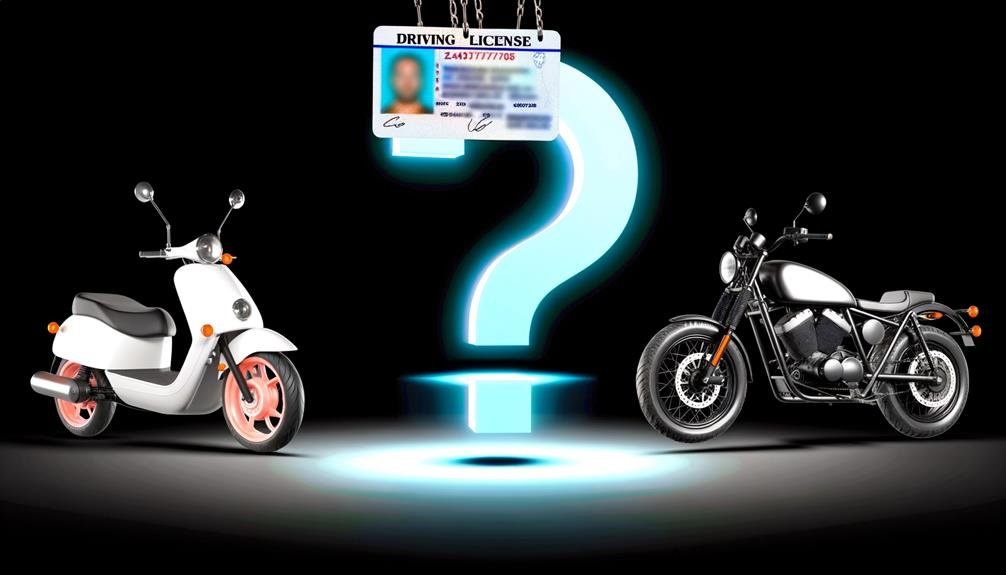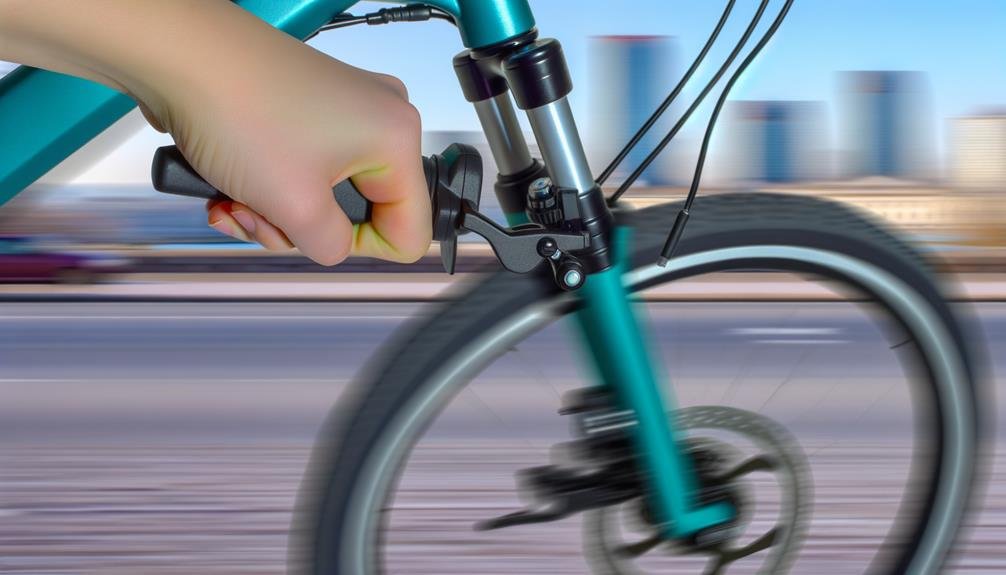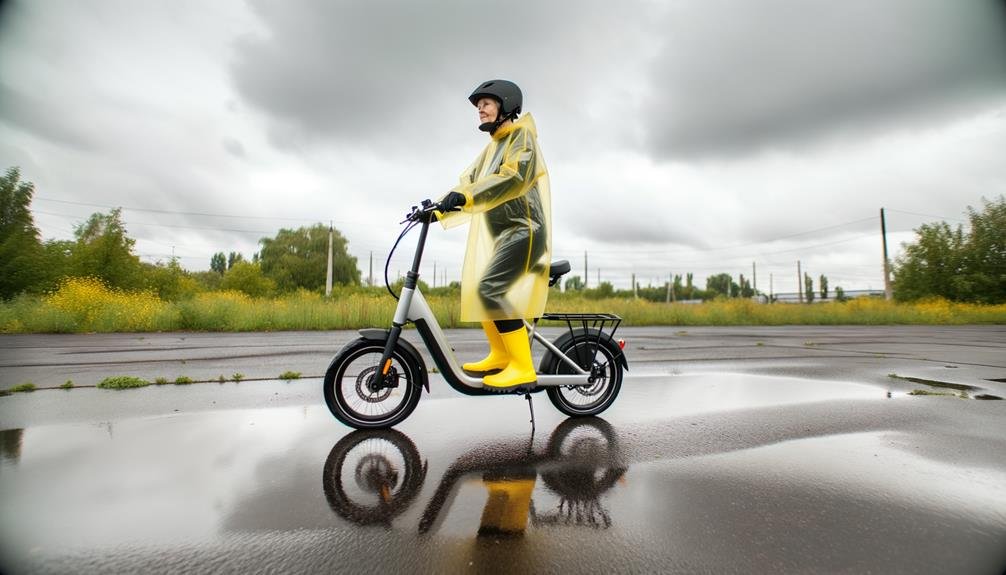Charles Miller is a veteran bike enthusiast with over 12 years of experience dealing with bikes as a mechanic. Despite immense love and expertise for...
It's fascinating to note that the global electric bike market is projected to reach $23.83 billion by 2025, a clear testament to their increasing popularity.
As enthusiasts and professionals, we've often pondered the question, 'How can we make these electric bikes faster?' While there's no one-size-fits-all answer, a myriad of factors come into play.
From upgrading the motor and optimizing battery power to adjusting riding posture and reducing air resistance, we'll explore all the possibilities.
So sit tight, because we're about to take you on an exhilarating journey into the world of electric bikes.
Curious to find out more? Let's get started.
Key Takeaways
- Upgrading the motor to a more powerful one with higher RPM and KV ratings can significantly increase electric bike speed.
- It is important to consider compatibility between the motor and the ebike model when upgrading for speed to avoid damage.
- Upgrading the battery to match the motor's requirements for increased speed is necessary for optimal performance.
- Optimizing battery power through strategies such as fully charging the battery, upgrading to a higher voltage battery, and adding more battery cells or choosing batteries with lower internal resistance can improve electric bike speed and performance.
Understanding Electric Bike Speed
To truly grasp the concept of electric bike speed, we must delve into various aspects including speed limitations, motor upgrades, battery voltage adjustments, tire pressure, bike settings, aerodynamics, weight reduction, and legal and safety considerations. It's critical to understand the ebike regulations and the implications of modifying an electric bike to go faster. We should consider the warranty and safety issues that could arise from tampering with the motor controller or adjusting the ebike battery to a high voltage.
Increasing the speed isn't just about motor upgrades or tweaking the speed sensor. The aerodynamics of the bike, the weight, and even the tire pressure can significantly influence the speed. By reducing the weight, optimizing the bike settings, and maintaining optimal tire pressure, we can enhance the speed without risking safety or violating regulations.
We must also consider how the motor and battery work together to produce speed. A better understanding of electric bike speed involves knowing how the motor draws power from the battery and how this relationship can be manipulated to increase speed. So, as we explore how to make an electric bike go faster, we're also deepening our understanding of the technology that powers it.
Upgrading the E-Bike Motor
We're now moving onto our next topic – upgrading the e-bike motor.
We'll examine how the right motor selection can enhance speed, simplify the installation process, and highlight essential maintenance practices for long-lasting motor performance.
Understanding these elements is crucial in achieving optimal e-bike speed and sustainability.
Choosing the Right Motor
If you're looking to increase the speed of your electric bike, one of the crucial factors you'll need to consider is upgrading to a more powerful motor with higher RPM and KV ratings. Choosing the right motor can significantly make your ebike faster.
Your max speed largely depends on electric motors. An integrated hub motor is a good choice for a new motor as it's compact and efficient. However, remember not all motors are suitable for all bikes. Before upgrading, ensure compatibility with your ebike model.
Also, it's not just about the motor; consider upgrading your battery to match the motor's requirements. A fully charged, higher voltage battery can indeed make your ebike go faster.
Optimizing settings on the motor controller can also enhance performance.
Installation Process Simplified
Having selected a suitable high-power motor and optimized the battery for your ebike, let's now simplify the process of installing the new motor.
First, ensure the battery is fully charged. Next, replace the battery with a higher voltage system if necessary. Remember, if the battery's voltage is too high, the motor will burn out.
After securing the new motor, install the conversion kit. This kit will make electric power delivery more efficient and increase the top speed. Carefully follow the manufacturer's instructions to avoid any missteps. Check the motor's compatibility with your ebike to avoid damaging the system.
Maintenance for Motor Longevity
To ensure our e-bike's motor lasts longer and performs optimally, upgrading to a more powerful motor with higher RPM and KV ratings can give us a significant boost in speed and performance. We must remember that electric bikes have speed limits, but with the right maintenance for motor longevity, we can make our electric ebike go faster and for longer periods.
Here are some changes we can make to our ebikes:
- Upgrade to a more powerful rear wheel motor or a mid-drive motor.
- Consult with the manufacturer or a technician about compatibility and rewinding the motor.
- Upgrade the battery to a higher voltage and always keep it fully charged.
- Adjust speed limiters through software upgrades or by disconnecting wires.
- Improve aerodynamics by adjusting tire pressure, adding a windshield, and reducing air resistance.
These steps can effectively make your ebike faster and its motor last longer.
Optimize Battery Power
Optimizing the power of your electric bike's battery can significantly boost its speed and overall performance. The life of your battery, and thus the speed of your ebike, is influenced by factors like how well you maintain it and the voltage your battery can achieve.
Let's break this down: A fully charged battery maximizes voltage, leading to greater speed. We can't emphasize enough the importance of keeping your battery in peak condition. Furthermore, you might consider upgrading to a higher voltage battery to increase power and speed.
To optimize battery power even more, consider adding more battery cells or choosing batteries with lower internal resistance. These tweaks can enhance the speed of your ebike, making it a more efficient and enjoyable ride.
We've summarized the strategies for optimizing battery power below:
| Strategy | Benefit |
|---|---|
| Full Charge | Maximizes voltage and speed |
| Battery Upgrade | Increases power and speed |
| Add Cells/Lower Resistance | Enhances speed |
In our Make Ebikes community, we believe in getting the most out of our rides. That's why optimizing battery power is key. So, let's get the most out of our ebikes and enjoy the ride.
Removing the Speed Limiter
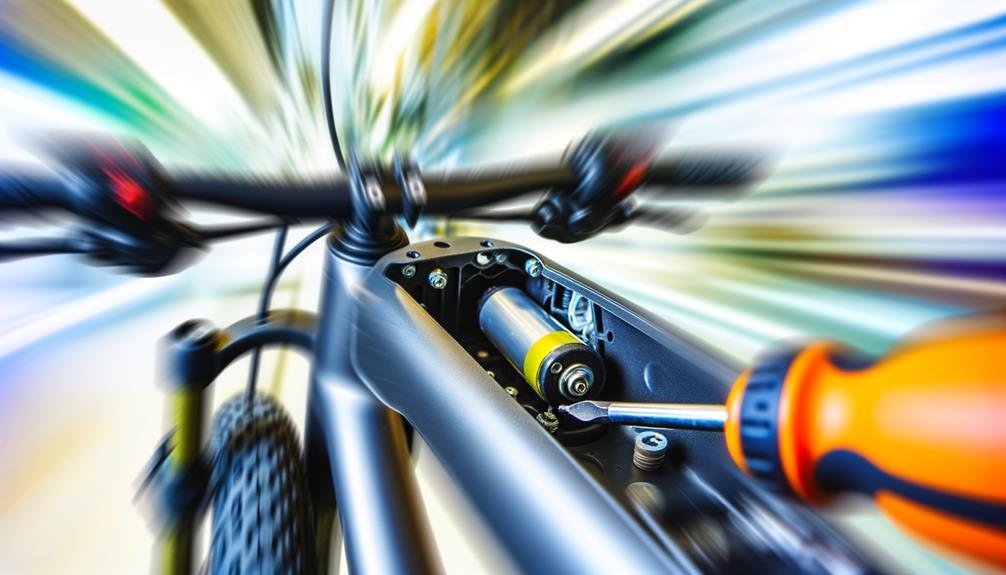
Now we're moving on to the topic of removing the speed limiter, a component that directly influences the top speed of electric bikes. We'll explore the technical aspects of how speed limiters function and discuss safe methods to bypass them.
Understanding Speed Limiters
In most electric bikes, speed limiters are implemented not only for regulatory compliance but also to ensure rider safety. These limiters prevent the bike from reaching speeds that could be dangerous or violate local e-bike laws.
Here's what we've learned about speed limiters:
- Most bikes have speed limiters installed by manufacturers.
- Removing the speed limiter can void the warranty of your Electric Bicycle.
- There's a sensor on the back wheel that you can manipulate to change the speed.
- You should understand local regulations concerning ebike speed before attempting any modifications.
- Some manufacturers may offer software upgrades to adjust speed settings.
Bypassing Limiter Safely
While bypassing the limiter on your electric bike might seem enticing, it's crucial to do so safely and within the confines of local government regulations.
We're talking about a motor speed of 92, and you might be wondering how to get your Ebikes to go Faster. Disconnecting a wire or tricking the speed sensor can turn off the limiter, but it's vital to contact the product manufacturer for support and warranty information. Some manufacturers even support lifting the speed limit through software upgrades.
Before attempting to increase your bike's speed, ensure you're familiar with local laws. Remember, our goal here is to safely increase the speed of your electric bike, not to create a dangerous situation.
It's about belonging to a community of responsible Ebike enthusiasts.
Maintaining Ideal Tire Pressure
Proper maintenance of tire pressure in our e-bikes not only ensures better traction and grip but also significantly reduces rolling resistance, thereby enabling faster speeds. Maintaining ideal tire pressure isn't just about performance; it's about making your ebike go the distance and enhancing your overall riding experience.
In order to maximize the speed of your electric bike, consider these critical points:
- Regularly check your ebike tires to ensure they aren't overinflated. Overinflation can lead to a harsher ride and reduced control.
- Underinflated tires increase the risk of flats and can significantly slow down your e-bike.
- Use a reliable tire pressure gauge to accurately measure tire pressure and adjust accordingly.
- High-speed road tires typically require higher pressure than off-road tires. Make sure to adjust the pressure depending on your riding conditions.
- Remember, lower rolling resistance achieved through ideal tire pressure equals higher speed and more efficient e-bike performance.
Understanding and maintaining ideal tire pressure is key to unlocking the full potential of your e-bike. Embrace this simple yet effective practice and enjoy a high-speed, smooth, and efficient ride every time.
Reducing Air Resistance

Having optimized our tire pressure for prime performance, let's now shift our focus to another crucial speed influencer – air resistance. When we ride our ebikes, we face the air, often feeling it as a wall against our forward motion. This air resistance can considerably slow down the speed of our ebikes. But by adopting a few strategies, we can make the bike move more swiftly, even becoming one of the fastest electric rides around.
Here's a handy markdown table that details some of the most effective methods for reducing air resistance:
| Method | Effect |
|---|---|
| Install a Windshield | Reduces air drag, increases speed by up to 3 mph |
| Adjust Riding Posture | Creates a more streamlined stance, reducing air resistance |
| Use Aero Clothing & Helmets | Reduces drag, increases speed and power |
| Attach Fairings | Improves aerodynamics, enhances top speed |
| Ride with a Charged Bike | Maintains optimal power output, improves speed |
Through these methods, we not only increase our speed but also enhance the power of our ebikes. So, the next time we take a ride, let's remember to ride with a charged bike and equipped with this knowledge on reducing air resistance.
Adjusting Riding Posture
Our ebike's speed can significantly benefit from a simple but effective tweak in our riding posture, creating a more streamlined shape that cuts through the air with ease. The way we position ourselves on the bike can determine how fast the bike is going. By adjusting our riding posture, we can make sure we're not only comfortable but also that our bike's speed is high.
Here are some points to consider when adjusting your riding posture:
- Maintain a straight back: An upright posture can increase wind resistance, slow us down. Keeping our backs straight and leaning slightly forward can help reduce this.
- Bending or crouching posture: This posture can be helpful when we're riding at high speeds to reduce wind resistance.
- Adjust the seat height: The height of the seat can affect our comfort and speed. It should be adjusted so that our legs can fully extend on the pedals.
- Keep your elbows slightly bent: This helps absorb shock from the road and lets you steer the bike more effectively.
- Position your feet properly on the pedals: Your foot should be flat and cover the entire pedal for maximum power transfer.
Considering Weight Factors
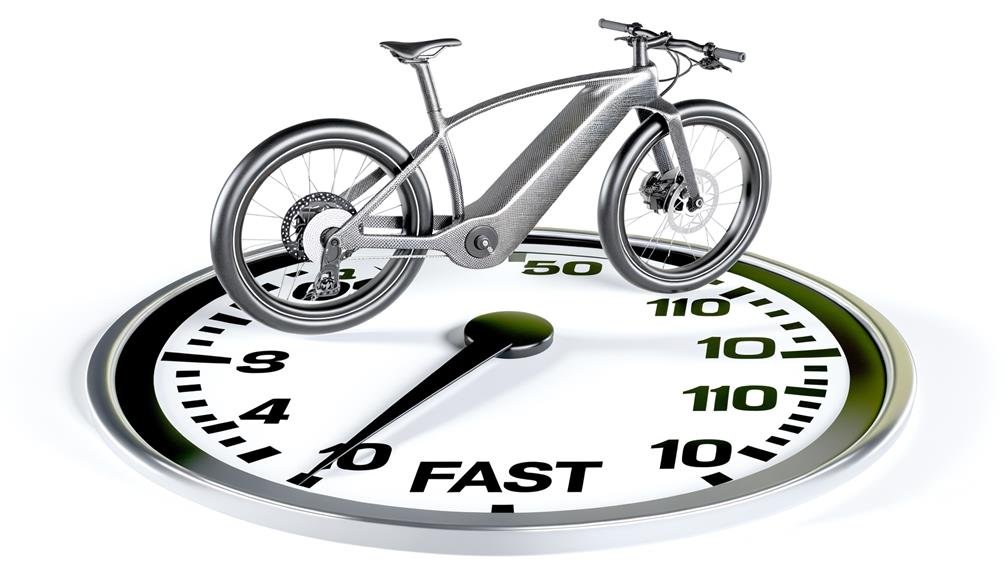
In evaluating the speed of our electric bikes, it's crucial to consider the various weight factors, as the overall weight – inclusive of the rider, cargo, and the bike itself – directly influences the power needed to reach maximum speed. The kind of speed we're aiming to achieve relies on a balance of watt and torque. Torque measures the force that makes our bikes rotate and move, while watt measures the rate of energy conversion or transfer.
When we make modifications to our bikes, we must consider the effects of higher voltage. Higher voltage could translate to a faster bike, but it also means the bike will go through its battery source faster. We're looking at speed instead of endurance here.
Reducing weight, both of the rider and the bike, can contribute to increased speed. Swapping heavy components for lighter ones allows for faster climbing and less effort, but we must ensure durability isn't compromised. Personal weight loss can also be a factor.
Frequently Asked Questions
How Do You Unlock the Speed Limit on an Electric Bike?
We're unlocking the speed limit on an e-bike by adjusting manufacturer settings, removing speed control. Remember, it impacts battery life, raises safety concerns, and may conflict with motor limitations, so check legality before throttling.
Can an Ebike Be Modified to Go Faster?
Yes, we can modify an ebike to go faster through motor upgrades, battery enhancements, gear adjustments, and aerodynamic improvements. But, we must consider legal implications, potential warranty issues, and safety risks.
How Do You Unrestrict an E-Bike?
To unrestrict an e-bike, we'll consider legal implications and safety measures. We'll enhance motor capacity, optimize battery, make controller adjustments, update the bike's firmware, and make mechanical alterations, including gearing changes.
Can an Electric Bike Go 60 Mph?
We're often asked if an electric bike can reach 60 mph. It's challenging due to factors like speed regulation, battery power, aerodynamics, gear adjustments, tire selection, frame weight, road conditions, and the rider's weight.
Conclusion
So, we've ventured deep into the mechanics of e-bikes, tinkered with motors, batteries, and limiters, and played with tire pressure and riding styles.
We've danced with the wind and considered every ounce of weight.
But remember, our quest for speed isn't over. There are always more tweaks, more upgrades, more techniques to discover.
Let's keep pushing boundaries and testing limits, always in pursuit of that thrilling, electric rush.
Onward, to the next speed frontier!

Charles Miller is a veteran bike enthusiast with over 12 years of experience dealing with bikes as a mechanic. Despite immense love and expertise for his Tacoma, he rides his Trek Ebike more. Anytime you meet him, you’ll either hear him talking about Bikes, or writing about all things bikes and cars on this blog.
More Posts
